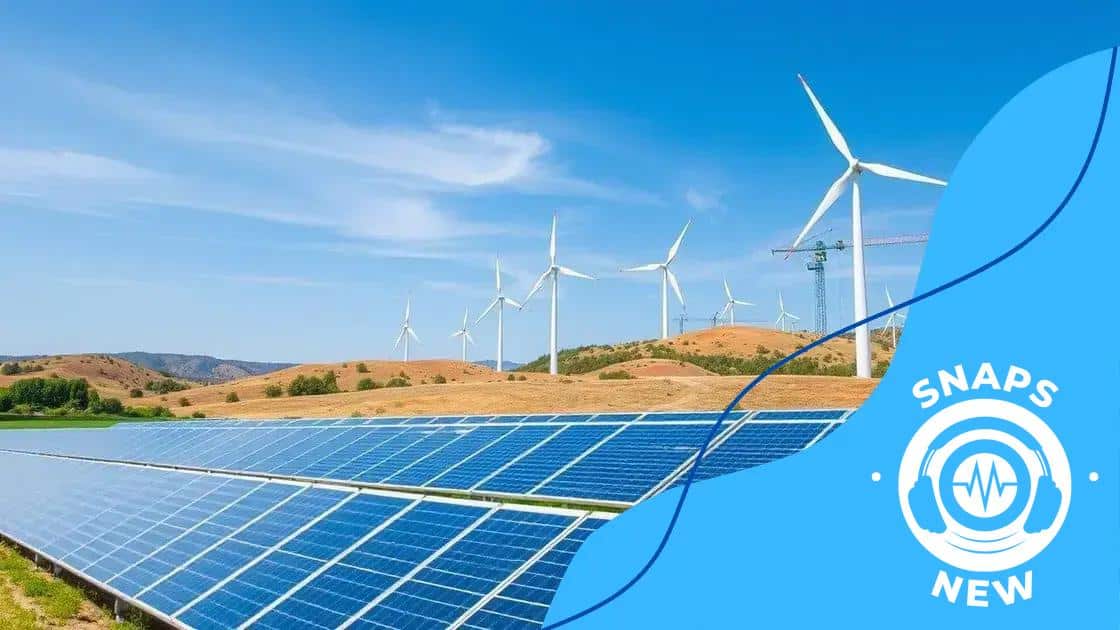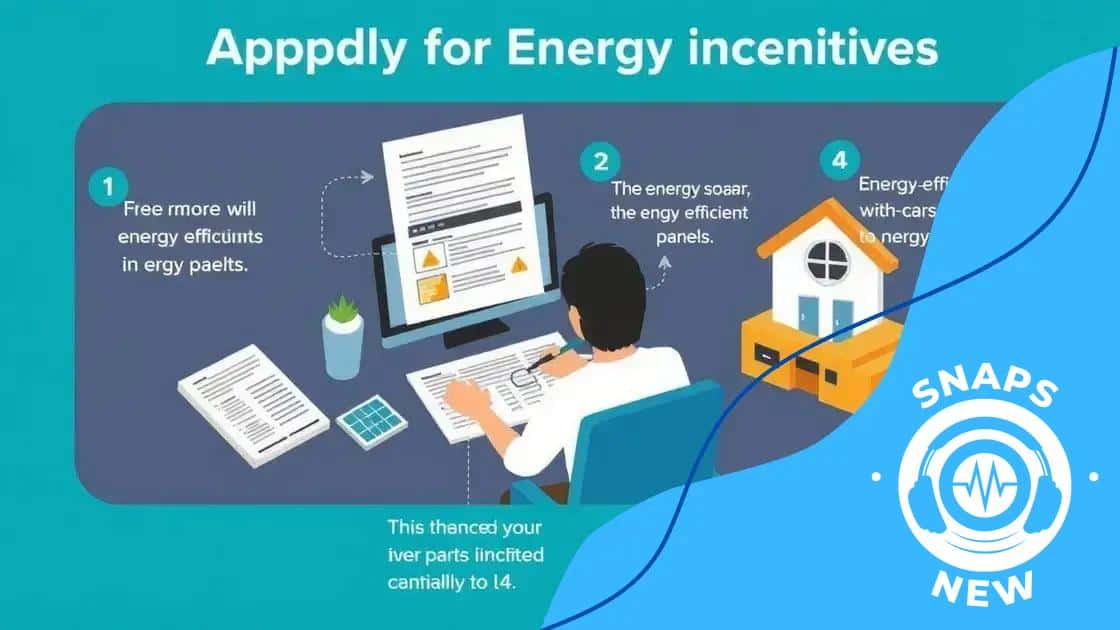Renewable energy incentives: saving money and the planet

Renewable energy incentives are financial benefits such as tax credits and rebates that encourage individuals and businesses to adopt clean energy technologies, leading to cost savings and environmental benefits.
Renewable energy incentives offer a fantastic opportunity for individuals and businesses to save money while contributing to a healthier planet. Have you ever wondered how these incentives work and what benefits they can bring? Let’s dive in!
Understanding renewable energy incentives
Understanding renewable energy incentives is crucial for anyone looking to make sustainable choices. These incentives can help offset the costs of transitioning to cleaner energy sources while benefiting the environment.
What Are Renewable Energy Incentives?
Renewable energy incentives are financial benefits provided by governments to encourage the use of renewable energy technologies. By making it easier for individuals and businesses to adopt these technologies, these incentives drive growth in the renewable energy sector.
Types of Renewable Energy Incentives
There are several types of incentives available, including:
- Tax credits: Reduce the income tax liability for individuals and businesses that invest in renewable technologies.
- Rebates: Offer direct cash back for purchasing renewable energy systems.
- Grants: Provide funding for larger projects that explore innovative technologies.
Each type of incentive has its own requirements and benefits, making it important to research and find the best options for your situation.
In addition to these incentives, many states and local governments have specific programs designed to promote renewable energy. These can include feed-in tariffs, where energy producers are paid a fixed rate for the energy they generate, and net metering, which allows users to offset their energy bills by generating their own electricity.
Understanding these various renewable energy incentives helps individuals and businesses to optimize their energy consumption and contribute to sustainability. Embracing renewable energies not only provides financial advantages but also plays a significant role in combating climate change.
Types of incentives available
There are various types of incentives available to encourage the use of renewable energy. Understanding these can help you choose the best options for your energy needs.
Tax Credits
Tax credits reduce the amount of income tax you owe. For example, the federal solar tax credit allows you to deduct a percentage of your solar system installation costs from your federal taxes.
Rebates
Rebates are direct cash incentives provided by local governments or energy companies. These can help cover part of the costs for solar panels, wind turbines, and energy-efficient appliances. They vary by location and can significantly reduce your upfront costs.
Grants
Grants are funds given to support renewable energy projects. They often come from government agencies or nonprofit organizations and do not need to be repaid. These funds can be used for research, development, and installation of renewable energy systems.
Loan Programs
Several programs offer low-interest loans for renewable energy upgrades. These loans can finance projects like solar installations or energy efficiency improvements. With this option, you can spread payment over time while enjoying the benefits of renewable energy right away.
In addition to these common incentives, many states and municipalities offer their own incentives, including net metering and feed-in tariffs. Net metering credits you for the surplus energy your renewable system generates, while feed-in tariffs provide a fixed payment for electricity produced from renewable sources.
Exploring these types of incentives can lead to significant savings and make switching to renewable energy easier. Each option has unique benefits, so it’s worth investigating what is available in your area.
How to apply for energy incentives

Applying for energy incentives can be a straightforward process if you know where to start. Many programs offer online applications, making it easy for you to submit your request from home.
Research Available Incentives
The first step is to research what energy incentives are available in your area. Each state and local government often has different programs. Look for websites that list these incentives, such as government portals or industry-specific websites.
Gather Necessary Documents
After you identify the incentives you want to apply for, you will need to gather the necessary documents. Common documents required include:
- Proof of income or tax returns.
- Receipts for energy-efficient products you purchased.
- Installation contracts for service providers.
Having these documents ready can make the application process smoother.
Complete the Application
Most applications require you to fill out a form, either online or on paper. Be sure to provide accurate information to avoid any delays. If you have questions, many programs have hotlines or FAQs to assist you.
Once your application is submitted, be patient. Processing times can vary based on the program. Additionally, keeping track of your application status can be helpful. If you don’t hear back, don’t hesitate to follow up with the agency.
Applying for energy incentives can lead to significant savings. By understanding the process and having your documents organized, you can take full advantage of the resources available to you.
Real-world success stories
Real-world success stories showcase how renewable energy incentives can have a profound impact on communities and individuals. These stories inspire others to take action and embrace sustainable energy.
Case Study: Solar Homeowner
One family in California decided to install solar panels on their roof. With the help of federal and state tax credits, they reduced their installation costs by nearly 30%. Now, they enjoy significantly lower energy bills and have cut their carbon footprint.
Community Solar Project
A small town in Colorado launched a community solar project funded through grants and local government incentives. Residents joined together to create a solar farm, allowing them to share the benefits of solar energy without the need for individual installations. This initiative provided clean energy to over 500 homes, demonstrating how renewable energy incentives can unite communities.
Nonprofit Organization Initiative
A nonprofit organization focused on improving energy efficiency in low-income neighborhoods secured grants for weatherization projects. By insulating homes and upgrading heating systems, they helped families save money and reduce energy consumption. Successful initiatives like this highlight the importance of targeted programs that ensure assistance reaches those who need it most.
These real-world examples illustrate the powerful effects of renewable energy incentives. They not only support financial savings but also promote environmental sustainability and strengthen communities. As more success stories emerge, they pave the way for future projects and inspire others to consider adopting renewable energy solutions.
Future trends in renewable energy incentives
Future trends in renewable energy incentives indicate exciting developments that could reshape the energy landscape. As technology advances and climate change awareness grows, we can expect to see more innovative approaches.
Increased Financial Incentives
Governments are likely to expand financial support for renewable energy. This could include higher tax credits and more generous rebates. By providing more substantial savings, they aim to motivate both individuals and businesses to adopt clean energy technologies.
Focus on Energy Storage
As renewable energy sources like solar and wind become more prevalent, energy storage technologies will gain importance. Incentives may soon cover battery storage systems, allowing homeowners to store surplus energy for later use. This can enhance energy independence and reduce reliance on the grid.
Community-Based Initiatives
We may also see a rise in community-based renewable energy projects. These initiatives often receive grants and financial backing to serve multiple residents or businesses. By pooling resources, communities can invest in larger renewable energy systems that benefit everyone.
Additionally, public-private partnerships will likely play a greater role in funding renewable energy projects. Collaboration between governments and private companies can drive innovation and lead to more efficient solutions.
Technological advancements will continue to shape how we harness renewable energy. Emerging technologies like floating solar panels or enhanced geothermal systems may become more common as they offer unique advantages.
Overall, the future of renewable energy incentives appears bright, with numerous opportunities for growth and innovation. Keeping an eye on these trends can help you make informed decisions regarding renewable energy investments.
FAQ – Frequently Asked Questions about Renewable Energy Incentives
What are renewable energy incentives?
Renewable energy incentives are financial benefits provided by governments to encourage the adoption of clean energy technologies, such as tax credits and rebates.
How can I apply for energy incentives?
You can apply for energy incentives by researching available programs in your area, gathering necessary documents, and submitting an application either online or via mail.
What are some real-world success stories of renewable energy incentives?
Success stories include homeowners reducing their energy bills through solar panel installations and communities collaborating on solar farms funded by grants.
What future trends should I be aware of regarding renewable energy incentives?
Future trends may include increased financial support, a focus on energy storage technologies, and the rise of community-based renewable energy projects.





